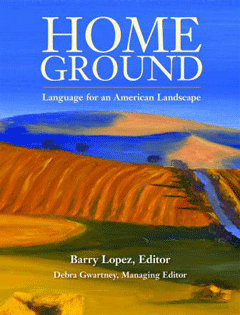The Language of Landscape
Air Date: Week of March 16, 2007

"Home Ground: Language for an American Landscape," edited by Barry Lopez and Debra Gwartney. (Courtesy of Trinity University Press)
Learn the meaning of the term “blind creek” from Barry Lopez, who edited the essay collection: “Home Ground: Language for an American Landscape”.
Transcript
CURWOOD: It’s Living on Earth. I’m Steve Curwood. Baboons are making themselves at home—in homes in the suburbs of Cape Town, South Africa. I’ll take you there in just a minute. But first, a visit to a little piece of our own country.
[MUSIC Daniel Lanois “O Marie” from ‘Arcadie’ (Daniellanois.com - 2005)]
CURWOOD: How well do we really know this place we call home? Forty-five American writers are helping us get to know it a little better in a new book called “Home Ground: Language for an American Landscape.” It’s basically a dictionary of hundreds of unique and unusual features of the vast American countryside. We invited some of the contributors to Home Ground to share definitions with us. And this week it’s Barry Lopez, with his definition of “Blind Creek.”

Home Ground: Language for an American Landscape, edited by Barry Lopez and Debra Gwartney.(Courtesy of Trinity University Press)
[CREEK SOUNDS]
CURWOOD: Barry Lopez is the editor along with Debra Gwartney of “Home Ground: Language for an American Landscape.” We’ll bring you more places from Home Ground in the weeks ahead.
[MUSIC: Amon Tobin “Kitchen Sink” from ‘Foley Room’ (Ninja Tune – 2007)]
Links
Living on Earth wants to hear from you!
Living on Earth
62 Calef Highway, Suite 212
Lee, NH 03861
Telephone: 617-287-4121
E-mail: comments@loe.org
Newsletter [Click here]
Donate to Living on Earth!
Living on Earth is an independent media program and relies entirely on contributions from listeners and institutions supporting public service. Please donate now to preserve an independent environmental voice.
NewsletterLiving on Earth offers a weekly delivery of the show's rundown to your mailbox. Sign up for our newsletter today!
 Sailors For The Sea: Be the change you want to sea.
Sailors For The Sea: Be the change you want to sea.
 The Grantham Foundation for the Protection of the Environment: Committed to protecting and improving the health of the global environment.
The Grantham Foundation for the Protection of the Environment: Committed to protecting and improving the health of the global environment.
 Contribute to Living on Earth and receive, as our gift to you, an archival print of one of Mark Seth Lender's extraordinary wildlife photographs. Follow the link to see Mark's current collection of photographs.
Contribute to Living on Earth and receive, as our gift to you, an archival print of one of Mark Seth Lender's extraordinary wildlife photographs. Follow the link to see Mark's current collection of photographs.
 Buy a signed copy of Mark Seth Lender's book Smeagull the Seagull & support Living on Earth
Buy a signed copy of Mark Seth Lender's book Smeagull the Seagull & support Living on Earth

